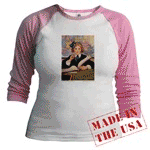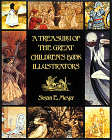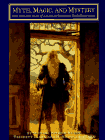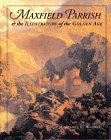| Introduction | Annotated Tales | eBooks | Bookstore | Illustration Gallery | Discussion Board | Blog |
 |
|
|
George Cruikshank From The Encyclopædia Britannica Eleventh Edition (1910–1911): English artist, caricaturist and illustrator, George Cruikshank was born in London on the 27th of September 1792. By natural disposition and collateral circumstances he may be accepted as the type of the born humoristic artist predestined for this special form of art. His grandfather had taken up the arts, and his father, Isaac Cruikshank, followed the painter's profession. Amidst these surroundings the children were born and brought up, their first playthings the materials of the arts their father practised. George followed the family traditions with amazing facility, easily surpassing his compeers as an etcher. When the father died, about 1811, George, still in his teens, was already a successful and popular artist. All his acquisitions were native gifts, and of home-growth; outside training, or the serious apprenticeship to art, were dispensed with, under the necessity of working for immediate profit. This lack of academic training the artist at times found cause to regret, and at some intervals he made exertions to cultivate the knowledge obtainable by studying from the antique and drawing from life at the schools. From boyhood he was accustomed to turn his artistic talents to ready account, disposing of designs and etchings to the printsellers, and helping his father in forwarding his plates. Before he was twenty his spirited style and talent had secured popular recognition; the contemporary of Gillray, Rowlandson, Alken, Heath, Dighton, and the established caricaturists of that generation, he developed great proficiency as an etcher. Gillray's matured and trained skill had some influence upon his executive powers, and when the older caricaturist passed away in 1815, George Cruikshank had already taken his place as a satirist. Prolific and dexterous beyond his competitors, for a generation he delineated Tories, Whigs and Radicals with fine impartiality. Satirical capital came to him from every public event, wars abroad, the enemies of England (for he was always fervidly patriotic), the camp, the court, the senate, the Church; low life, high life; the humours of the people, the follies of the great. In this wonderful gallery the student may grasp the popular side of most questions which for the time being engaged public attention. George Cruikshank's technical and manipulative skill as an etcher was such that Ruskin and the best judges have placed his productions in the foremost rank; in this respect his works have been compared favourably with the masterpieces of etching. He died at 263 Hampstead Road on the 1st of February 1878. His remains rest in St Paul's cathedral. A vast number of Cruikshank's spirited cartoons were published as separate caricatures, all coloured by hand; others formed series, or were contributed to satirical magazines, the Satirist, Town Talk, The Scourge (1811-1816) and the like ephemeral publications. In conjunction with William Hone's scathing tracts, G. Cruikshank produced political satires to illustrate the series of facetiae and miscellanies, like The Political House that Jack Built (1819) . Of a more genially humoristic order are his well-known book illustrations, now so deservedly esteemed for their inimitable fun and frolic, among other qualities, such as the weird and terrible, in which he excelled. Early in this series came The Humorist (1819-1821) and Life Paris (1822). The well-known series of Life in London, conjointly produced by the brothers I. R. and G. Cruikshank, has enjoyed a prolonged reputation, and is still sought after by collectors. Grimm's Collection of German Popular Stories (1824-1826), in two series, with 22 inimitable etchings, are in themselves sufficient to account for G. Cruikshank's reputation. To the first fourteen volumes (1837-1843) of Bentley's Miscellany Cruikshank contributed 126 of his best plates, etched on steel, including the famous illustrations to Oliver Twist, Jack Sheppard, Guy Fawkes and The Ingoldsby Legends. For W. Harrison Ainsworth, Cruikshank illustrated Rookwood (1836) and The Tower of London (1840); the first six volumes of Ainsworth's Magazine (1842-1844) were illustrated by him with several of his finest suites of etchings. For C. Lever's Arthur O'Leary he supplied io full-page etchings (1844), and 20 spirited graphic etchings for Maxwell's lurid History of 1798 (1845). Of his own speculations, mention must be made of George Cruikshank's Omnibus (1841) and George Cruikshank's Table Book (1845), as well as his Comic Almanack (1835-1853). The Life of Sir John Falstaff contained 20 full-page etchings (1857-1858). These are a few leading items amongst the thousands of illustrations emanating from that fertile imagination. As an enthusiastic teetotal advocate, G. Cruikshank produced a long series of pictures and illustrations, pictorial pamphlets and tracts; the best known of these are The Bottle, 8 plates (1847), with its sequel, The Drunkard's Children, 8 plates (1848), with the ambitious work, The Worship of Bacchus, published by subscription after the artist's oil painting, now in the National Gallery, London, to which it was presented by his numerous admirers. Below are links to the fairy tale illustrations of George Cruikshank. Click on the image to visit the page featuring all of the illustrations for each tale. Titles of some books illustrated by George Cruikshank: Grimm, Jacob and Wilhelm. German Popular Stories. George Cruikshank, illustrator. Edward Taylor, translator. London: C. Baldwyn, 1823. Italian Tales (1824) Basile, Giambattista. The Pentamerone, or The Story of Stories. John Edward Taylor, translator. George Cruikshank, illustrator. Edgar Taylor, editor. London: David Bogue, 1847. Cruikshank, George, editor and illustrator. Cinderella and the Glass Slipper. Part of George Cruikshank's Fairy Library. London: David Bogue, [n.d., 1854]. Cruikshank, George, editor and illustrator. The History of Jack & the Bean-Stalk. Part of George Cruikshank's Fairy Library. London: David Bogue, [n.d., 1854]. Cruikshank, George, editor and illustrator. Puss in Boots. Part of George Cruikshank's Fairy Library. London: Routledge, Warne & Routledge, [n.d., 1864]. |
|
©Heidi
Anne Heiner, SurLaLune Fairy Tales |
















